本文小编为大家详细介绍“Android性能优化电量的方法是什么”,内容详细,步骤清晰,细节处理妥当,希望这篇“Android性能优化电量的方法是什么”文章能帮助大家解决疑惑,下面跟着小编的思路慢慢深入,一起来学习新知识吧。
1)Understanding Battery Drain
手机各个硬件模块的耗电量是不一样的,有些模块非常耗电,而有些模块则相对显得耗电量小很多。
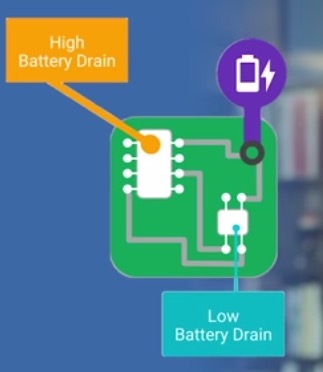
电量消耗的计算与统计是一件麻烦而且矛盾的事情,记录电量消耗本身也是一个费电量的事情。唯一可行的方案是使用第三方监测电量的设备,这样才能够获取到真实的电量消耗。
当设备处于待机状态时消耗的电量是极少的,以N5为例,打开飞行模式,可以待机接近1个月。可是点亮屏幕,硬件各个模块就需要开始工作,这会需要消耗很多电量。
使用WakeLock或者JobScheduler唤醒设备处理定时的任务之后,一定要及时让设备回到初始状态。每次唤醒蜂窝信号进行数据传递,都会消耗很多电量,它比WiFi等操作更加的耗电。
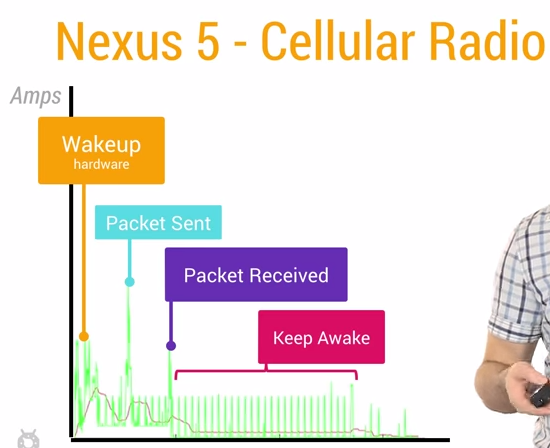
2)Battery Historian
Battery Historian是Android 5.0开始引入的新API。通过下面的指令,可以得到设备上的电量消耗信息:
$ adb shell dumpsys batterystats > xxx.txt //得到整个设备的电量消耗信息 $ adb shell dumpsys batterystats > com.package.name > xxx.txt //得到指定app相关的电量消耗信息得到了原始的电量消耗数据之后,我们需要通过Google编写的一个python脚本把数据信息转换成可读性更好的html文件:
$ python historian.py xxx.txt > xxx.html打开这个转换过后的html文件,可以看到类似TraceView生成的列表数据,这里的数据信息量很大,这里就不展开了。
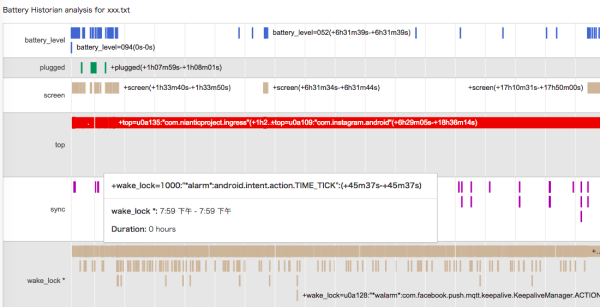
3)Track Battery Status & Battery Manager
我们可以通过下面的代码来获取手机的当前充电状态:
// It is very easy to subscribe to changes to the battery state, but you can get the current // state by simply passing null in as your receiver. Nifty, isn't that? IntentFilter filter = new IntentFilter(Intent.ACTION_BATTERY_CHANGED); Intent batteryStatus = this.registerReceiver(null, filter); int chargePlug = batteryStatus.getIntExtra(BatteryManager.EXTRA_PLUGGED, -1); boolean acCharge = (chargePlug == BatteryManager.BATTERY_PLUGGED_AC); if (acCharge) { Log.v(LOG_TAG,“The phone is charging!”); }在上面的例子演示了如何立即获取到手机的充电状态,得到充电状态信息之后,我们可以有针对性的对部分代码做优化。比如我们可以判断只有当前手机为AC充电状态时 才去执行一些非常耗电的操作。
/** * This method checks for power by comparing the current battery state against all possible * plugged in states. In this case, a device may be considered plugged in either by USB, AC, or * wireless charge. (Wireless charge was introduced in API Level 17.) */ private boolean checkForPower() { // It is very easy to subscribe to changes to the battery state, but you can get the current // state by simply passing null in as your receiver. Nifty, isn't that? IntentFilter filter = new IntentFilter(Intent.ACTION_BATTERY_CHANGED); Intent batteryStatus = this.registerReceiver(null, filter); // There are currently three ways a device can be plugged in. We should check them all. int chargePlug = batteryStatus.getIntExtra(BatteryManager.EXTRA_PLUGGED, -1); boolean usbCharge = (chargePlug == BatteryManager.BATTERY_PLUGGED_USB); boolean acCharge = (chargePlug == BatteryManager.BATTERY_PLUGGED_AC); boolean wirelessCharge = false; if (Build.VERSION.SDK_INT >= Build.VERSION_CODES.JELLY_BEAN_MR1) { wirelessCharge = (chargePlug == BatteryManager.BATTERY_PLUGGED_WIRELESS); } return (usbCharge || acCharge || wirelessCharge); }4)Wakelock and Battery Drain
高效的保留更多的电量与不断促使用户使用你的App会消耗电量,这是矛盾的选择题。不过我们可以使用一些更好的办法来平衡两者。
假设你的手机里面装了大量的社交类应用,即使手机处于待机状态,也会经常被这些应用唤醒用来检查同步新的数据信息。Android会不断关闭各种硬件来延长手机的待机时间,首先屏幕会逐渐变暗直至关闭,然后CPU进入睡眠,这一切操作都是为了节约宝贵的电量资源。但是即使在这种睡眠状态下,大多数应用还是会尝试进行工作,他们将不断的唤醒手机。一个最简单的唤醒手机的方法是使用PowerManager.WakeLock的API来保持CPU工作并防止屏幕变暗关闭。这使得手机可以被唤醒,执行工作,然后回到睡眠状态。知道如何获取WakeLock是简单的,可是及时释放WakeLock也是非常重要的,不恰当的使用WakeLock会导致严重错误。例如网络请求的数据返回时间不确定,导致本来只需要10s的事情一直等待了1个小时,这样会使得电量白白浪费了。这也是为何使用带超时参数的wakelock.acquice()方法是很关键的。
但是仅仅设置超时并不足够解决问题,例如设置多长的超时比较合适?什么时候进行重试等等?解决上面的问题,正确的方式可能是使用非精准定时器。通常情况下,我们会设定一个时间进行某个操作,但是动态修改这个时间也许会更好。例如,如果有另外一个程序需要比你设定的时间晚5分钟唤醒,***能够等到那个时候,两个任务捆绑一起同时进行,这就是非精确定时器的核心工作原理。我们可以定制计划的任务,可是系统如果检测到一个更好的时间,它可以推迟你的任务,以节省电量消耗。
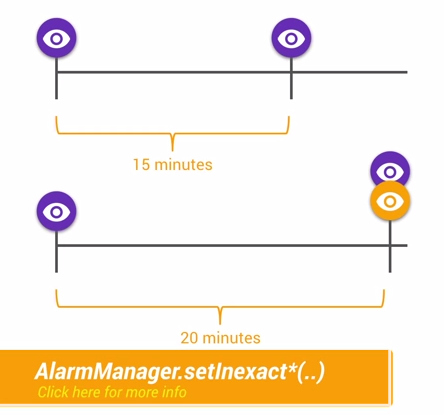
这正是JobScheduler API所做的事情。它会根据当前的情况与任务,组合出理想的唤醒时间,例如等到正在充电或者连接到WiFi的时候,或者集中任务一起执行。我们可以通过这个API实现很多免费的调度算法。
5)Network and Battery Drain
下面内容来自官方Training文档中高效下载章节关于手机(Radio)蜂窝信号对电量消耗的介绍。
通常情况下,使用3G移动网络传输数据,电量的消耗有三种状态:
Full power: 能量***的状态,移动网络连接被激活,允许设备以***的传输速率进行操作。
Low power: 一种中间状态,对电量的消耗差不多是Full power状态下的50%。
Standby: ***的状态,没有数据连接需要传输,电量消耗最少。
下图是一个典型的3G Radio State Machine的图示

总之,为了减少电量的消耗,在蜂窝移动网络下,***做到批量执行网络请求,尽量避免频繁的间隔网络请求。
通过前面学习到的Battery Historian我们可以得到设备的电量消耗数据,如果数据中的移动蜂窝网络(Mobile Radio)电量消耗呈现下面的情况,间隔很小,又频繁断断续续的出现,说明电量消耗性能很不好:
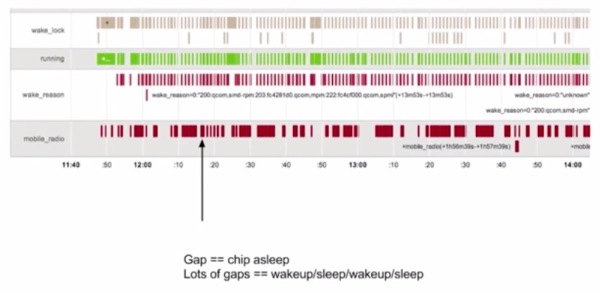
经过优化之后,如果呈现下面的图示,说明电量消耗的性能是良好的:
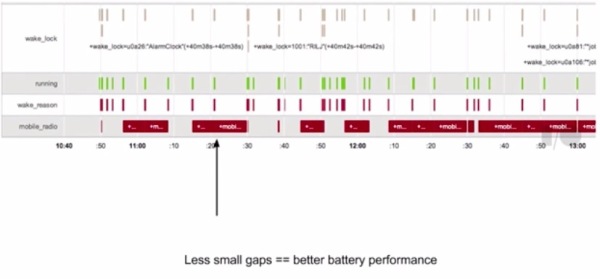
另外WiFi连接下,网络传输的电量消耗要比移动网络少很多,应该尽量减少移动网络下的数据传输,多在WiFi环境下传输数据。
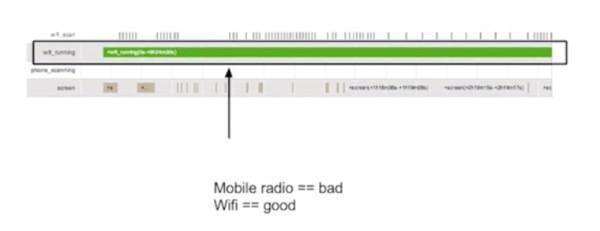
那么如何才能够把任务缓存起来,做到批量化执行呢?下面就轮到Job Scheduler出场了。
6)Using Job Scheduler
使用Job Scheduler,应用需要做的事情就是判断哪些任务是不紧急的,可以交给Job Scheduler来处理,Job Scheduler集中处理收到的任务,选择合适的时间,合适的网络,再一起进行执行。
下面是使用Job Scheduler的一段简要示例,需要先有一个JobService:
public class MyJobService extends JobService { private static final String LOG_TAG = "MyJobService"; @Override public void onCreate() { super.onCreate(); Log.i(LOG_TAG, "MyJobService created"); } @Override public void onDestroy() { super.onDestroy(); Log.i(LOG_TAG, "MyJobService destroyed"); } @Override public boolean onStartJob(JobParameters params) { // This is where you would implement all of the logic for your job. Note that this runs // on the main thread, so you will want to use a separate thread for asynchronous work // (as we demonstrate below to establish a network connection). // If you use a separate thread, return true to indicate that you need a "reschedule" to // return to the job at some point in the future to finish processing the work. Otherwise, // return false when finished. Log.i(LOG_TAG, "Totally and completely working on job " + params.getJobId()); // First, check the network, and then attempt to connect. if (isNetworkConnected()) { new SimpleDownloadTask() .execute(params); return true; } else { Log.i(LOG_TAG, "No connection on job " + params.getJobId() + "; sad face"); } return false; } @Override public boolean onStopJob(JobParameters params) { // Called if the job must be stopped before jobFinished() has been called. This may // happen if the requirements are no longer being met, such as the user no longer // connecting to WiFi, or the device no longer being idle. Use this callback to resolve // anything that may cause your application to misbehave from the job being halted. // Return true if the job should be rescheduled based on the retry criteria specified // when the job was created or return false to drop the job. Regardless of the value // returned, your job must stop executing. Log.i(LOG_TAG, "Whelp, something changed, so I'm calling it on job " + params.getJobId()); return false; } /** * Determines if the device is currently online. */ private boolean isNetworkConnected() { ConnectivityManager connectivityManager = (ConnectivityManager) getSystemService(Context.CONNECTIVITY_SERVICE); NetworkInfo networkInfo = connectivityManager.getActiveNetworkInfo(); return (networkInfo != null && networkInfo.isConnected()); } /** * Uses AsyncTask to create a task away from the main UI thread. This task creates a * HTTPUrlConnection, and then downloads the contents of the webpage as an InputStream. * The InputStream is then converted to a String, which is logged by the * onPostExecute() method. */ private class SimpleDownloadTask extends AsyncTask<JobParameters, Void, String> { protected JobParameters mJobParam; @Override protected String doInBackground(JobParameters... params) { // cache system provided job requirements mJobParam = params[0]; try { InputStream is = null; // Only display the first 50 characters of the retrieved web page content. int len = 50; URL url = new URL("https://www.google.com"); HttpURLConnection conn = (HttpURLConnection) url.openConnection(); conn.setReadTimeout(10000); //10sec conn.setConnectTimeout(15000); //15sec conn.setRequestMethod("GET"); //Starts the query conn.connect(); int response = conn.getResponseCode(); Log.d(LOG_TAG, "The response is: " + response); is = conn.getInputStream(); // Convert the input stream to a string Reader reader = null; reader = new InputStreamReader(is, "UTF-8"); char[] buffer = new char[len]; reader.read(buffer); return new String(buffer); } catch (IOException e) { return "Unable to retrieve web page."; } } @Override protected void onPostExecute(String result) { jobFinished(mJobParam, false); Log.i(LOG_TAG, result); } } }然后模拟通过点击Button触发N个任务,交给JobService来处
public class FreeTheWakelockActivity extends ActionBarActivity { public static final String LOG_TAG = "FreeTheWakelockActivity"; TextView mWakeLockMsg; ComponentName mServiceComponent; @Override protected void onCreate(Bundle savedInstanceState) { super.onCreate(savedInstanceState); setContentView(R.layout.activity_wakelock); mWakeLockMsg = (TextView) findViewById(R.id.wakelock_txt); mServiceComponent = new ComponentName(this, MyJobService.class); Intent startServiceIntent = new Intent(this, MyJobService.class); startService(startServiceIntent); Button theButtonThatWakelocks = (Button) findViewById(R.id.wakelock_poll); theButtonThatWakelocks.setText(R.string.poll_server_button); theButtonThatWakelocks.setOnClickListener(new View.OnClickListener() { @Override public void onClick(View v) { pollServer(); } }); } /** * This method polls the server via the JobScheduler API. By scheduling the job with this API, * your app can be confident it will execute, but without the need for a wake lock. Rather, the * API will take your network jobs and execute them in batch to best take advantage of the * initial network connection cost. * * The JobScheduler API works through a background service. In this sample, we have * a simple service in MyJobService to get you started. The job is scheduled here in * the activity, but the job itself is executed in MyJobService in the startJob() method. For * example, to poll your server, you would create the network connection, send your GET * request, and then process the response all in MyJobService. This allows the JobScheduler API * to invoke your logic without needed to restart your activity. * * For brevity in the sample, we are scheduling the same job several times in quick succession, * but again, try to consider similar tasks occurring over time in your application that can * afford to wait and may benefit from batching. */ public void pollServer() { JobScheduler scheduler = (JobScheduler) getSystemService(Context.JOB_SCHEDULER_SERVICE); for (int i=0; i<10; i++) { JobInfo jobInfo = new JobInfo.Builder(i, mServiceComponent) .setMinimumLatency(5000) // 5 seconds .setOverrideDeadline(60000) // 60 seconds (for brevity in the sample) .setRequiredNetworkType(JobInfo.NETWORK_TYPE_ANY) // WiFi or data connections .build(); mWakeLockMsg.append("Scheduling job " + i + "!\n"); scheduler.schedule(jobInfo); } } }读到这里,这篇“Android性能优化电量的方法是什么”文章已经介绍完毕,想要掌握这篇文章的知识点还需要大家自己动手实践使用过才能领会,如果想了解更多相关内容的文章,欢迎关注亿速云行业资讯频道。
亿速云「云服务器」,即开即用、新一代英特尔至强铂金CPU、三副本存储NVMe SSD云盘,价格低至29元/月。点击查看>>
免责声明:本站发布的内容(图片、视频和文字)以原创、转载和分享为主,文章观点不代表本网站立场,如果涉及侵权请联系站长邮箱:is@yisu.com进行举报,并提供相关证据,一经查实,将立刻删除涉嫌侵权内容。